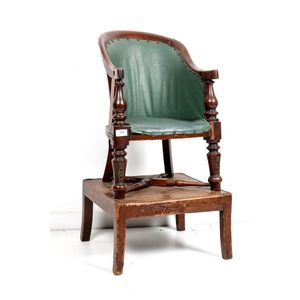George III Oak and Elm Elbow Chair
A country George III oak and elm elbow chair the curved cresting rail above a carved splat, with out swept arms and wooden seat on ring turned legs.
You must be a subscriber, and be logged in to view price and dealer details.
Subscribe Now to view actual auction price for this item
When you subscribe, you have the option of setting the currency in which to display prices to $Au, $US, $NZ or Stg.
This item has been sold, and the description, image and price are for reference purposes only.
- Oak - Native to Europe and England, oak has been used for joinery, furniture and building since the beginning of the medieval civilisation. It is a pale yellow in colour when freshly cut and darkens with age to a mid brown colour.
Oak as a furniture timber was superceded by walnut in the 17th century, and in the 18th century by mahogany,
Semi-fossilised bog oak is black in colour, and is found in peat bogs where the trees have fallen and been preserved from decay by the bog. It is used for jewellery and small carved trinkets.
Pollard oak is taken from an oak that has been regularly pollarded, that is the upper branches have been removed at the top of the trunk, result that new branches would appear, and over time the top would become ball-like. . When harvested and sawn, the timber displays a continuous surface of knotty circles. The timber was scarce and expensive and was used in more expensive pieces of furniture in the Regency and Victorian periods. - George Iii - George III (1738 - 1820) was King of Great Britain and Ireland from 1760 to 1820.
- Turning - Any part of a piece of furniture that has been turned and shaped with chisels on a lathe. Turned sections include legs, columns, feet, finials, pedestals, stretchers, spindles etc. There have been many varieties and fashions over the centuries: baluster, melon, barley-sugar, bobbin, cotton-reel, rope-twist, and so on. Split turning implies a turned section that has been cut in half lengthwise and applied to a cabinet front as a false decorative support.
- Splat - The central back support between the top rail and the seat in chairs and couches. They may take a variety of forms, and run either horizontally or vertically.
- Turned Legs - are legs which have been turned on a lathe. In use from the 16th century, turned legs on tables, chairs and cabinets became more frequent until, by the 1830s, the Georgian square or tapered leg was rarely found except in country pieces.
- Rail - A term used by cabinet makers for the horizontal sections of the frame of an item such as a chair or settee which have a front rail, a back rail and two side rails, and also on a door or carcase, where the rails are joined to the vertical framings.
- Cresting - The decorative carving at the top of a piece of furniture, such as a sideboard back, a mirror, or a chair back.
- Elbow Chair - Another name given to a dining chair with arms, more commonly called a carver chair.
This item has been included into following indexes:
- chairs, singles - Georgian 542
-
chairs, singles / pairs / threes, style or period
- country style 91
- elbow 191
- elm 223
- chairs, singles / pairs / threes, timber - oak 488
Visually similar items

A French Empire style mahogany upholstered desk chair.
Sold by
in
for
You can display prices in $Au, $US, $NZ or Stg.

An English late Georgian elm and beech arm chair
Sold by
in
for
You can display prices in $Au, $US, $NZ or Stg.

Child's high chair Germanic, c1860, oak, mounted, on a Biedermeier stool
Sold by
in
for
You can display prices in $Au, $US, $NZ or Stg.

A pair of wicker armchairs, height 95 cm
Sold by
in
for
You can display prices in $Au, $US, $NZ or Stg.
